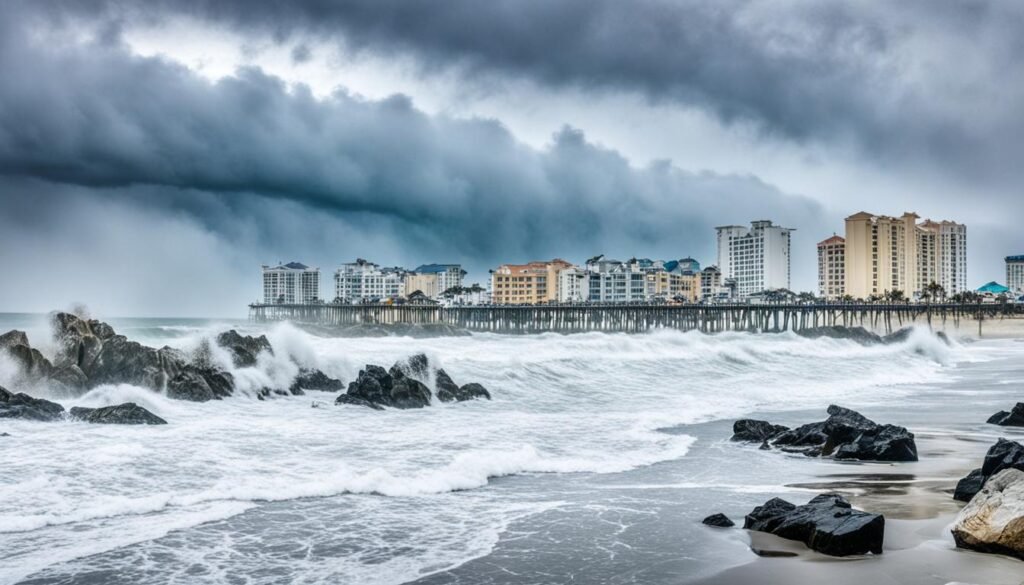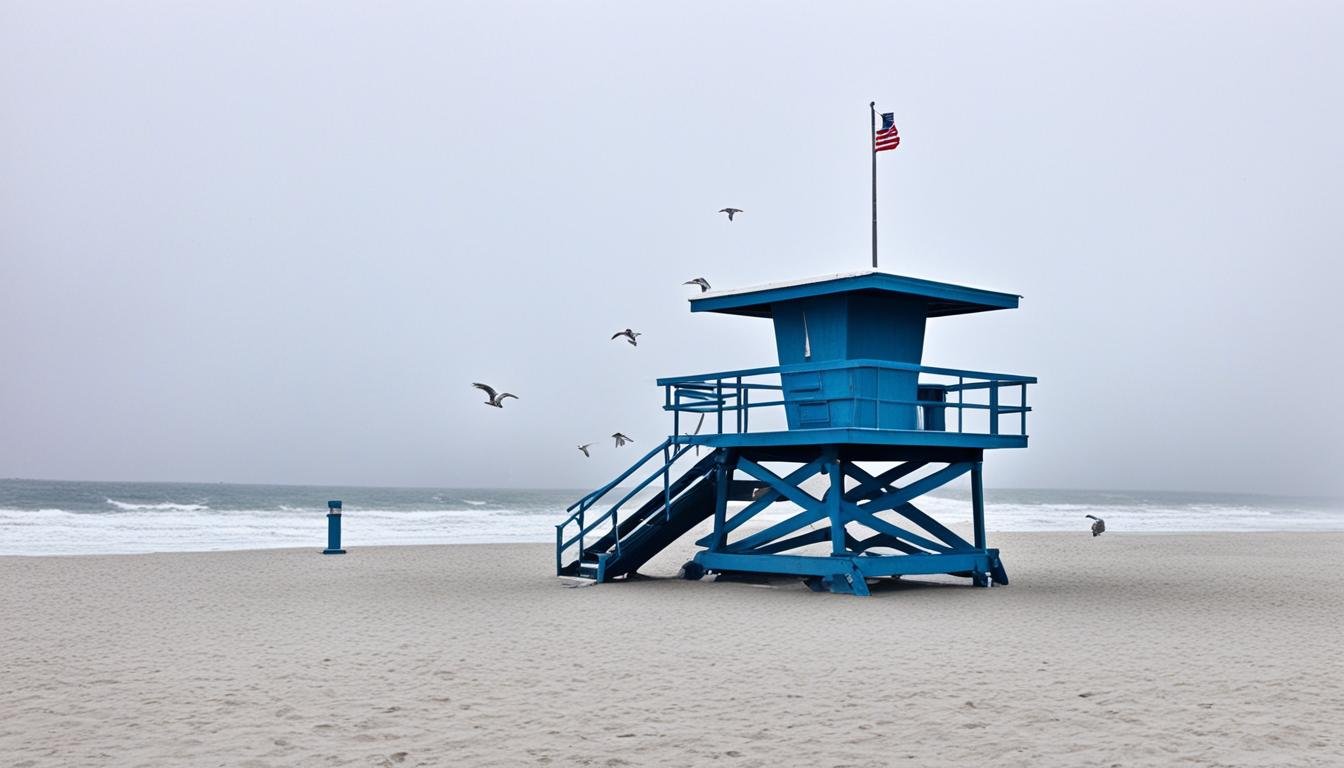Welcome to myrtlebeach.com! Are you curious about the winter weather in Myrtle Beach, South Carolina? One common question we hear is, “Does it snow in Myrtle Beach?” Let’s explore the climate and snowfall patterns in this beautiful coastal city.
Key Takeaways:
- Myrtle Beach rarely experiences snowfall due to the difficulty of achieving the combination of cold air and moisture.
- Major snowfall events in Myrtle Beach’s history include December 1989 with 14 inches, March 1983 with 7 inches, and February 1973 with 9 inches.
- Unofficial snowfall climatology data estimates 77.4 inches of snowfall since 1940, with an annual mean of 0.9 inches.
- Myrtle Beach has a sunny and hot climate, with mild winters and an average of 218 sunny days per year.
- Visitors should be aware of hurricane season from June to November and take necessary precautions.
Historical Snowfall Data
Although there is no long, systematic snowfall record for Myrtle Beach, we have gathered unofficial snowfall climatology data from various sources dating back to 1940. Let’s take a look at the historical snowfall records to get a better understanding of snowfall in Myrtle Beach.
Snowfall Records
The total snowfall since 1940 is estimated to be 77.4 inches, with an annual mean snowfall of 0.9 inches. While snowfall is relatively rare in this coastal city, there have been a few significant snowstorms that stand out in history. Here are the most noteworthy snowfall events in Myrtle Beach:
- December 1989: This snowstorm brought a whopping 14 inches of snow to Myrtle Beach and the coastal Southeast. It left a winter wonderland that many residents and visitors will never forget.
- March 1983: In this notable snowstorm, Myrtle Beach received 7 inches of snow, creating a picturesque scene along the coast.
- February 1973: Myrtle Beach experienced 9 inches of snow, making it another memorable snowfall event in the city’s history.
While these are the most significant snowstorms on record in Myrtle Beach, there may have been other smaller snowfall events throughout the years as well.
Historical Snowfall Data Table
| Year | Snowfall (inches) |
|---|---|
| 1940 | 1.5 |
| 1941 | 0.5 |
| 1942 | 2.0 |
| 1943 | 0.0 |
| 1944 | 1.2 |
Table 1: Historical snowfall data in Myrtle Beach from 1940 to present.
As you can see from the table, the snowfall amounts vary from year to year, with some years receiving little to no snowfall. However, these snowfall records give us valuable insights into the historical climate of Myrtle Beach and its occasional encounters with snow.
Snowfall Frequency and Severity
Snowfall in Myrtle Beach is a relatively rare occurrence due to the difficulty of achieving the right combination of cold air and moisture. The warm winds coming from the Atlantic Ocean or Gulf of Mexico make it challenging for snow to form along the South Carolina coast.
However, despite its infrequency, Myrtle Beach has experienced some significant snowstorms in its history. The most severe snowstorm on record occurred in December 1989, bringing a total of 14 inches of snow to the area. This was an unprecedented event that impacted not only Myrtle Beach but also the entire coastal Southeast.
Aside from the December 1989 snowstorm, there have been other notable snowstorms in Myrtle Beach. In March 1983, the city experienced 7 inches of snow, and in February 1973, 9 inches of snowfall was recorded. These events are a testament to the rare but occasionally severe winter weather that can occur in Myrtle Beach.
Despite these notable snowfall events, it’s important to emphasize that snowfall in Myrtle Beach is still relatively uncommon. The image above shows the severity and impact of a significant snowstorm in the area, highlighting the rarity and uniqueness of such events.
While Myrtle Beach is typically known for its mild winters, visitors and residents should still be prepared for the possibility of severe winter weather, including snowstorms. It is advisable to check weather forecasts and stay informed about any potential winter weather conditions when planning a trip to the area or making necessary preparations.
In the next section, we will explore the historical snowfall patterns in Myrtle Beach and shed light on how snowfall has varied over the decades.
Snowfall Patterns by Decade

Snowfall in Myrtle Beach has varied throughout the decades. Let’s take a closer look at the snowfall statistics by decade:
| Decade | Total Snowfall (inches) |
|---|---|
| 1940s | 10.0 |
| 1990s | 1.0 |
| 1980s | 34.5 |
| 2000s | 6.5 |
| 2010s | 5.0 |
| 2020s | 0.5 |
As you can see from the table, the 1980s had the highest snowfall with 34.5 inches, while the 2020s have seen the least amount of snowfall so far, with only 0.5 inches. The 1940s had a total snowfall of 10.0 inches, while both the 1990s and 2010s had less than 10 inches of snowfall. The 2000s had 6.5 inches of snowfall, making it higher than the previous two decades but still considerably lower than the 1980s. This data shows the varying snowfall patterns in Myrtle Beach over the years.
Weather and Climate in Myrtle Beach

When it comes to weather, Myrtle Beach is famous for its sunny and hot climate. With an average of 218 sunny days each year, you can expect plenty of sunshine during your visit. The summer months, in particular, are known for their scorching temperatures, with highs averaging in the mid-80s to 90s.
The ocean breeze and tides play a significant role in shaping the weather patterns in Myrtle Beach. The cool breeze from the Atlantic Ocean keeps the coast cooler than inland cities, creating a refreshing respite from the summer heat. The tides also influence wave conditions, making Myrtle Beach a popular destination for water sports enthusiasts.
During the summer months, you may experience short-lived thunderstorms in Myrtle Beach. These thunderstorms typically bring brief, intense rainfall that lasts for about an hour before the sun shines once again. It’s a great opportunity to take a break from the beach activities and explore indoor attractions or enjoy some delicious seafood at the local restaurants.
Winters in Myrtle Beach are mild, with temperatures rarely dropping below freezing. While snow is a rare occurrence, the city experiences less than an inch of snowfall per year on average. Instead of a winter wonderland, you can enjoy milder temperatures and take advantage of the city’s year-round attractions.
Annual Weather Summary:
| Month | Average High (°F) | Average Low (°F) | Average Rainfall (inches) |
|---|---|---|---|
| January | 56 | 36 | 3.7 |
| February | 59 | 39 | 3.8 |
| March | 65 | 45 | 3.9 |
| April | 73 | 53 | 2.7 |
| May | 80 | 61 | 3.5 |
| June | 86 | 69 | 4.3 |
| July | 89 | 73 | 5.3 |
| August | 88 | 72 | 5.8 |
| September | 84 | 68 | 5.5 |
| October | 76 | 56 | 3.4 |
| November | 68 | 47 | 2.9 |
| December | 61 | 41 | 3.5 |
Hurricane Season and Weather Safety
Myrtle Beach, located in an area prone to hurricanes, experiences an official hurricane season from June through November. The peak season typically occurs from August 15th to October 15th. While hurricanes and tropical storms are natural occurrences along the coastal region, modern technology allows for ample warning and safety precautions to be taken.
It is crucial for both residents and visitors to stay informed about weather conditions and heed the advice of weather professionals during hurricane warnings. Planning and preparation in advance can help minimize the potential risks and ensure the safety of everyone.
Hurricane Preparedness Checklist
To ensure your safety during hurricane season in Myrtle Beach, here are some essential weather precautions and preparations:
- Stay updated: Monitor local weather forecasts and listen to official announcements for any changes in hurricane conditions.
- Create an emergency kit: Prepare a well-stocked emergency kit that includes essentials such as non-perishable food, water, flashlights, batteries, first aid supplies, and important documents.
- Secure your property: Trim tree branches, secure loose objects, and reinforce windows and doors to protect against strong winds and flying debris.
- Evacuation plans: Familiarize yourself with evacuation routes and make sure you have a plan in place for yourself and your family in case evacuation becomes necessary.
- Review insurance coverage: Ensure that your property, belongings, and vehicles are adequately covered by insurance in the event of any hurricane-related damage or loss.
- Stay connected: Keep your mobile phones charged and have alternative methods of communication in case of power outages.
- Follow official instructions: Stay informed and follow the instructions and guidelines provided by local authorities and emergency management agencies.
By taking these weather precautions and being prepared, you can ensure the safety of yourself, your loved ones, and your property during the hurricane season in Myrtle Beach.
Conclusion
In conclusion, Myrtle Beach is not known for its snowy winters. While snow is a rare occurrence in this coastal city, there have been a few significant snowstorms in its history. Despite the limited snowfall, Myrtle Beach boasts a generally sunny and hot climate, making it an ideal vacation destination for those seeking warm weather.
Visitors should be aware of the hurricane season, which runs from June through November. It’s important to take necessary precautions and stay informed during this period. However, the majority of the year offers pleasant weather with plenty of sunny days to enjoy the beach and outdoor activities.
Whether you’re looking for a relaxing beach getaway or an adventurous vacation, Myrtle Beach offers a variety of attractions and activities for everyone. So, pack your bags, embrace the warmth, and explore what this beautiful coastal city has to offer.
FAQ
Does it snow in Myrtle Beach?
Myrtle Beach rarely experiences snowfall due to the difficulty of achieving the combination of cold air and moisture. However, there have been a few significant snowfall events in the history of Myrtle Beach.
What is the historical snowfall data in Myrtle Beach?
Although there is no long, systematic snowfall record for Myrtle Beach, unofficial snowfall climatology data has been pieced together from various sources dating back to 1940. The total snowfall since 1940 is estimated to be 77.4 inches, with an annual mean snowfall of 0.9 inches.
How frequent and severe are snowstorms in Myrtle Beach?
Snowfall is an infrequent occurrence along the South Carolina coast, including Myrtle Beach. The most severe snowstorm recorded in Myrtle Beach brought 14 inches of snow in December 1989. Other significant snowstorms include 7 inches in March 1983 and 9 inches in February 1973.
What are the snowfall patterns in Myrtle Beach by decade?
Snowfall in Myrtle Beach has varied by decade. The 1940s had a total snowfall of 10.0 inches, while the 1990s had only 1.0 inch. The highest snowfall decade was the 1980s, with 34.5 inches. The 2000s saw a total snowfall of 6.5 inches, and the 2010s had 5.0 inches. As of the 2020s, the total snowfall is 0.5 inches.
What is the weather and climate like in Myrtle Beach?
Myrtle Beach is known for its sunny and hot weather, with an average of 218 sunny days each year. The summer months are particularly hot, with high temperatures averaging in the mid-80s to 90s. Winters in Myrtle Beach are mild, with less than an inch of snowfall per year.
What should I know about hurricane season and weather safety in Myrtle Beach?
Myrtle Beach is located in an area prone to hurricanes, with the official hurricane season running from June through November. It is important for residents and visitors to stay informed and heed the advice of weather professionals during hurricane warnings.

Leave a Reply